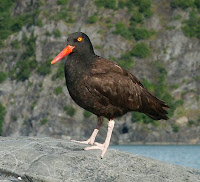 The USGS is conducting a migration study on black oystercatchers, a large, distinctive shorebird species. Since their habitat is limited to rocky coastlines and their global population is small, black oystercatchers are of conservation concern. Learning more about their movements and distribution outside of the breeding season can help ensure that critical habitat is preserved.
The USGS is conducting a migration study on black oystercatchers, a large, distinctive shorebird species. Since their habitat is limited to rocky coastlines and their global population is small, black oystercatchers are of conservation concern. Learning more about their movements and distribution outside of the breeding season can help ensure that critical habitat is preserved.
Government scientists captured a small number of oystercatchers and fitted them with either a satellite or VHF transmitter. Satellite transmitters were implanted in the birds' abdomens while VHF transmitters were strapped to their backs. The birds were caught on their breeding grounds at sites across the southern shore of Alaska.
As with bar-tailed godwits, you can follow the movements of black oystercatchers with Google Earth. Visit the USGS black oystercatcher site for the latest satellite tracking data. The image below shows the birds' positions as of Monday.



